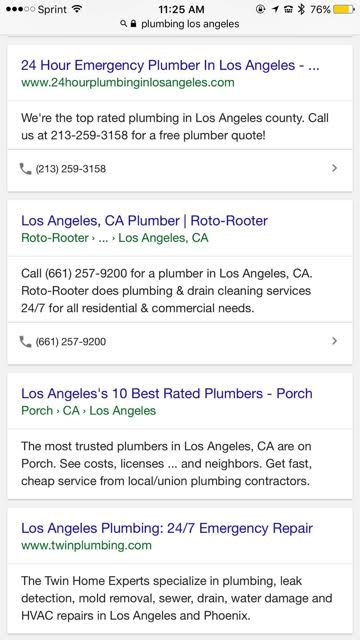Half of all potential sales are lost simply because consumers are unable to find the information they’re looking for, especially on mobile devices. This could be your business information, such as the phone number, address, or name, that customers are having trouble locating on their mobile devices. This type of local SEO mistake can cost a business countless missed opportunities.
18% of local smartphone searches led to a purchase within a day, which means you can’t just optimize for local without thinking about mobile anymore. More people are using mobile devices than desktop to search, so if you aren’t optimizing your local campaigns to address mobile users, you’re going to miss out on conversions.
With mobile searches rising and businesses constantly competing against their competitors down the street, I decided to reach out to the SEO industry and ask what a business can do to optimize their local SEO strategies for mobile users. The response – a lot! Optimizing for mobile is like throwing everything we what know about desktop user experience out the window and thinking in real time. What actions do you make on your own mobile device? How do you search on mobile?
Without furtherado, let’s see what advice the experts had.
Three Tips You Need to Implement Immediately
- Update your local listings. If you have a local business, you probably have several websites that have listed you without input from you. Do a search, find them, and update them with the proper information.
- Add direct data to your website with a more robust About page. Direct data is your name, address, phone number, but it’s also your hours, when you close, pricing, if (for restaurants) you do take-out or delivery, etc.
- Optimize for voice search. People search differently with typing than they do with voice. By optimizing for voice search, you can still hit desktop ranking, but you also add mobile ranking to the mix.

Gabriella Sannino is an international SEO consultant and writer. Follow her on Twitter at @SEOcopy.
Optimize For the Phone Call Extension
Optimize your phone number to obtain the Phone Call Extension in your mobile SERP results. At some point in time, most smart phones started recognizing phone numbers and making them clickable automatically and site owners stopped hard coding Click-to-Call links into their websites. It’s time to add them back!


Shelly Fagin is a digital marketing strategist who specializes in assisting business owners dominate locally online for the past 15 years. Follow Shelly on Twitter at @shellyfagin.
Have Consistency With All of Your Citations
One of the biggest issues I see is inconsistent NAP data in citations. Businesses will have different phone numbers, duplicate listings, citations with different versions of their address. Once that is all cleaned up it makes a huge difference in local rankings.
Small businesses , for example, might use one phone number (a cell phone) at first, and get some listings. Then later they may switch to a different phone number as they grow. Old phone numbers and even home addresses can be put there, and doing a proper citation cleanup is key.

Bill Hartzer is an SEO consultant, specializing in SEO, link, and local citation audits. He has over 20 years of SEO experience and was previously the Senior Vice President of Agency Services at Advice Local.
Customize Your Schema For Your Business
Using Schema markup is an important part of accurately communicating to the search engines what your product or service is. Unfortunately for some, the Schema.org website does not list every conceivable product or service. What many local businesses do is choose a definition for their product or service that is close enough.
A little known tip is that small businesses can use Wikipedia pages and a site called ProductOntology.org to more accurately define their business. So rather than use a general description, you can be absolutely accurate in your Schema. If there is a Wikipedia page that accurately describes your business, service or product, you can use that and Google will recognize it. More information is available at the http://www.productontology.org/.

Roger Montti has been working on the web for himself and clients since 1999. Although known for producing a popular link building newsletter, Roger Montti is also an expert at site reviews and local search optimization.
Think of Speed When it Comes to Mobile
Focus on mobile Load Speed on a 3G connection and not a 4G. This isn’t achieved by cheating with AMP. It is done by having a great localized or cloud cache hosting environment. We use Lightspeed NGINX with our own hosting, never a host farm like HostGator or Godaddy.
You need to have a great child theme framework and excellent plugin control while using server-side caching instead of just relying on WP Cache or some random WordPress Plugin to do the servers job.
 BIO:
BIO:Mike Stewart is the online marketing master famous for helping business owners improve their online marketing results. With more than 15 years of local media experience under his belt, Mike is a long standing Dallas/Fort Worth Search Engine Marketing Association Board of Directors Member and popular presenter at Pubcon, the World’s Leading Digital Marketing Conferences.
Geotag Photos With Their Location
When businesses and agencies think of local SEO, especially for mobile, they rarely think of optimizing their Google and Bing ranking via the use of photos that have meta data. This includes geotagging (longitude and latitude location / GPS coordinates) where the photo was taken.
Using photos that have geotagging meta data embedded within them on a business website and uploading those same images to Google My Business, as well as Bing Places for Business, helps provide search engines with an increased understanding of where a business is located and optimizes a website / business from a local SEO prospective.
For many people, geotagging is done automatically when they take a picture on their mobile device and when it comes to optimizing for local SEO, geotagging can boost search engine visibility for those who are searching for the products / services that a business may provide within a specific region. For example, if someone types “Restaurants Paris, France” in Google, the search engine will take all the available data it knows about restaurants in Paris and present the user.
There are many factors that contribute to optimizing local SEO results such as making sure the business is listed in Google My Business as well as Bing Places for Business, has build the correct citations, has the correct NAP data on their website, listed on Yelp, Facebook Locations, etc… but having images that are tagged with geo meta data reinforces all other data points to tell search engines where a business is at due to the fact that the photo has specific geotagging information on the location.
While quite easy to do, this is often overlooked but certainly something that would be considered to help businesses increase the number of leads generated, improve revenue, ROI and the LTV (live time value) of a customer.
As a side note, I would also upload these photos to:
- The Contact Us page of the website, where it will hopefully be on the same page as the business address.
- Business profiles on social media including Instagram, Facebook, Twitter and Foursquare.
Bio:
Dror Zaifman is a talented savvy marketing professional whose experience in digital marketing, web analytics, and conversion optimization helped companies increase lead generation, sales revenue, net income, and ROI. Get more SEO advice by following Dror on Twitter at @onwebanalytics.
Optimize For Voice Search on Mobile
Aside from the regular ‘best practice’ local SEO tips (such as consistent name, address phone information external citations and on your website (I like to use JSON-LD), I’d recommend considering optimizing for voice search.
The reason for this, is that voice search is most popular on mobile devices, combine that with the fact that one third of all mobile searches are local, I think we have a pretty solid argument for at least thinking about voice search when optimizing for LoMo (Local, Mobile).
Some basic tips for optimizing for voice search:
- Optimize for featured snippets (these tend to be more prevalent in voice search, with Google even reading out some snippets to users).
- Sit down & think about how people use voice search – When possible, pay attention to how family & friends use voice search (but not in a creepy way!) and start to use this insight to feed into your content and SEO strategy, writing articles that would be a good result for the way people search when using their voice.
- Write content that answers questions can be a good start, especially common questions in your industry or that arise during your sales process (always, always take note of questions prospects ask before they turn into customers, this can be gold dust for article ideation! If you have sales staff, as them to keep a note of questions too).
- Mark-up your content with structured data. Study what schema options are out there and what would work for you. At a minimum, I’d recommend local business schema and marking-up your articles. I’m a fan of JSON-LD personally (you can also use Google Tag Manager to dynamically insert JSON-LD). There’s plenty of articles about optimizing for voice search, so I’d recommend grabbing a coffee and reading a few.
If I’m allowed to sneak in a couple of little PPC tips here too, If you’re running Adword campaigns, check to see if you are using Call Extensions as this can be great for providing an easy CTA for mobile users, and consider at least testing running ads on Google Maps, using Promoted Pins.

Mike Gracia is the strategy director at both Thinkable Ltd & Curation Wall, as well as working as a freelance digital marketing consultant.
Perform Audits Regularly
Great SEO, whether mobile or not, always starts with comprehensive auditing and creative strategies around technical, contextual and off-page visibility focal points. In the corporate world, the audits typically include:
- Obstacle Analysis Report & Action Plan
- Competitive Analysis Report (baseline)
- Link Analysis Report & Strategy
- Keyword Discovery & Site Taxonomy
Another tip to improving long term Organic traffic growth would be to put someone in charge of testing, as a full time position.
Schedule the different tests and experiments you’d like to run for the next 3-6 months, making sure none of them overlap the same target pages. Areas we test often include enhancements to titles, meta descriptions, headings, and AMP pages.
Be sure to annotate EVERYTHING in Google Analytics, so you can trace changes in rankings or traffic back to the experiment that made have triggered it.
Lastly, spend 30 minutes per day following popular search blogs via Feedly, particularly the Google Webmaster Central Blog, Search Engine Land, Search Engine Journal, and Search Engine Roundtable. It also wouldn’t hurt putting contributors to this post in an SEO Expert Twitter list, for that daily dose of real time expert news.
Bio:



